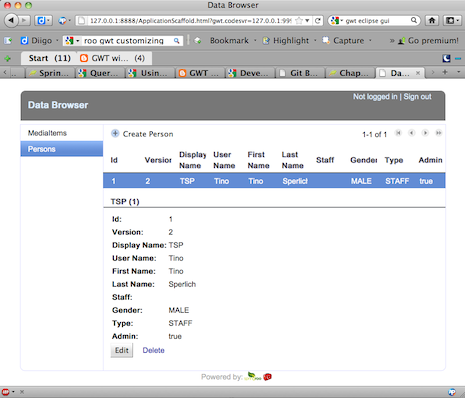« Die Gier, die nach **** in mir | Main | NKOTB »
Sonntag, Oktober 23, 2011
GWT spring roo ts
Ich will Spring IOC, DI und frameworks. Ich will eine Java-Umgebung als Hoster, möglichst kostengünstig: GAE. Ich will GWT und GAE und CRUD. ohne dafür GUIs bauen zu müssen. Ich will die neuesten GWT-Sachen (Eventbus, Activity, Places). Ich will mich mit einer einfachen DSL auf die Domäne konzentrieren, nicht auf den Request-Zyklus oder Persistenz.
Aber wie immer gilt auch hier: Besser man ist mal zu Fuß den Weg gegangen, eine Web 2.0 App mit GAE, GWT, Spring zu bauen, ansonsten steht man bei den ersten roo-Fehler im Regen. Und man sollte das "roo-Undo" mit git unbedingt nutzen. Sonst ist schnell mal was hingeneriert, was keiner braucht... In jeden Fall ist post-generatem immer mal gut, zu wissen was roo so alles raushaut.
Basic building blocks:
Editor Framework
You might be wondering how the generated application reads and
writes entity objects from and to the view. It is all hidden away inside
the GWT Editor Framework, which provides the functionality implicitly,
using the marker interface pattern.
The RequestFactory
The RequestFactory and JPA provide an easy way to build
data-oriented CRUD applications and together make up the data-access
layer of our Roo-generated application.Built to complement the
service-oriented GWT RPC and not replace it, the data-oritented
RequestFactory is GWT's new mechanism that provides more efficient
client/server data transfer. It allows us to define data-centric Entity
classes on the server side and to define business logic with EntityProxy
on the client side.
Entity
Entity s are server-side Data Access Objects (DAO) in our
RequestFactory mechanism and should be placed in a package that will not
be converted to JavaScript by GWT.
EntityProxy
Objects that implement the EntityProxy interface are Data Transfer
Objects (DTO) and client-side representations of corresponding Entity
objects. The exclusive use of EntityProxy interface on the client side
relieves us from the requirement of writing GWT-compatible code in our
Entity implementations.The BaseProxy interface, along with others that
extend EntityProxy interface, enables RequestFactory to determine fields
that have changed and send only these changes to the server.
Activity Pattern
In the application that Roo has generated for us, the Activity is
the implementation of the Presenter component and IsWidget is the
implementation of the View component of our MVP pattern.
Activity
An Activity is completely isolated from the view and contains no
widgets or UI code. This isolation greatly simplifies the testing of
logic contained within an Activity.
Place
A Place is a bookmarkable state for a Web application. An Activity
needs a corresponding Place in order to be accessible via a URL. It has
an associated PlaceTokenizer that serializes the Place's state to a URL
token.
PlaceController
The PlaceController manages the current Place and navigation
between Places in a Web application and makes the back-button and
bookmarks work as users would expect.
Also ans Werk mit meinem Medienboten-Projekt und diesem Script:
project --topLevelPackage de.tixus.roo.mb
persistence setup --provider DATANUCLEUS --database
GOOGLE_APP_ENGINE
enum type --class ~.shared.domain.Gender
enum constant --name MALE
enum constant --name FEMALE
enum type --class ~.shared.domain.TypeOfPerson
enum constant --name CUSTOMER
enum constant --name STAFF
enum type --class ~.shared.domain.MediaKind
enum constant --name BOOK
enum constant --name BIGFONT
enum constant --name CD
entity --class ~.server.domain.Person --testAutomatically
field string --fieldName displayName --notNull
field string --fieldName userName --sizeMin 3 --sizeMax 30
--notNull
field string --fieldName firstName
field string --fieldName lastName
field reference --type Person staff
field enum --fieldName gender --type ~.shared.domain.Gender
field enum --fieldName type --type ~.shared.domain.TypeOfPerson
field boolean --fieldName admin --notNull
entity --class ~.server.domain.MediaItem --testAutomatically
field string --fieldName mediaNumber --notNull
field string --fieldName title --notNull
field string --fieldName shortDescription
field number --type java.lang.Integer publicationYear
field enum --fieldName mediaKind --type ~.shared.domain.MediaKind
field number --type java.lang.Integer amount
field reference --type ~.server.domain.Person lentTo
web mvc setup
web mvc all --package ~.web
-- web mvc language --code de
security setup
gwt setup
logging setup --level DEBUG
>mvn gwt:run
Probleme:
Plugin execution not covered by lifecycle configuration: org.datanucleus:maven-datanucleus-plugin:1.1.4:enhance (execution: default, phase: compile) pom.xml /mb line 710 Maven Project Build Lifecycle Mapping Problem
->Use quick fix
Project configuration is not up-to-date with pom.xml. Run project configuration update mb line 1 Maven Configuration Problem
->maven->update project configuration
->Add roo project nature
Enables roo shell and allows for Google WebApplication
->Run As ... Google WebApplication -Tataa:
